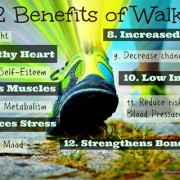BENEFITS OF WALKING
Now is the time to start the spring/summer walking program. The goal is to walk 10 000 steps a day…but why walking and why 10 000 steps? It is estimated that the average person walks about 2 – 3 miles everyday to complete normal daily activities. This average person roughly takes 2000 steps to walk a mile meaning that we take between 4000 – 6000 steps just to live.
A 30 minute brisk walk will more than make up the difference so that we can complete 10 000 steps in a day. Research has conclusively shown that 30 minutes of moderate intensity activity will improve our health. Some will say I do not have 30 minutes a day to walk – well that excuse does not work anymore. Research also shows that the 30 minutes can be accumulated with three 10 minute sessions and we all can find three 10 minute sessions in almost every day. If not, I believe you need to rethink the priorities in your life.
In 2001 Australia’s Queensland Health created the Rockhampton 10 000 Step Project to try and increase physical activity in an area that had low physical activity to start with. The project was an exemplary model of an effective multi-strategy, multi-sector physical activity project that successfully motivates at the local community, workplace and individual level. In 2004 Queensland Health increased the funding and expanded the project due to the results.
Regular walking at a brisk pace increases circulation, boosts energy, enhances mood, reduces depression, decreases stress, can increase muscle activation and bone strength, improves balance and flexibility, boosts immune function and improves sleeping patterns. A brisk walk can burn up to 300 calories per hour helping with weight loss and weight maintenance improving health outcomes for overweight and obese. After meals a brisk walk can help to regulate blood glucose, triglycerides and blood pressure. Regular walking decreases the risk of health issues such as heart disease, hypertension, diabetes, some forms of cancer, osteoporosis…as well as helping to manage many of these conditions.
Walking, like other regular physical activities, increases the ability of people with chronic disabling diseases (arthritis, MS etc) to perform activities of daily living.
The positive impact of walking goes beyond the physical as regular walking has cognitive benefits as well. It improves memory and logic in seniors, increases brain function and academic performance in pre-adolescents. It can be used to refresh and invigorate during meetings and work sessions leading to increased creativity and clarity.
Walking is a form of activity or exercise (depending on intensity of movement) that anyone can do. There really is no excuse for not walking everyday, even if you have a busy schedule or are low on funds. All you need is a good pair of shoes and a sidewalk or trail or park or path or mall.
We can increase the intensity of our walking and therefore healthy outcomes when we are ready by increasing the pace, pick a corner or sign and get there as fast as you can. Walking hills are stairs are also easy ways to increase the intensity. This can become an interval session by repeating the same hill or set of stairs 4 – 10 times.
For more information on starting a walking program or getting more information (ie. pedometer use) check out the Alberta Centre for Active Living www.centre4activeliving.ca.




